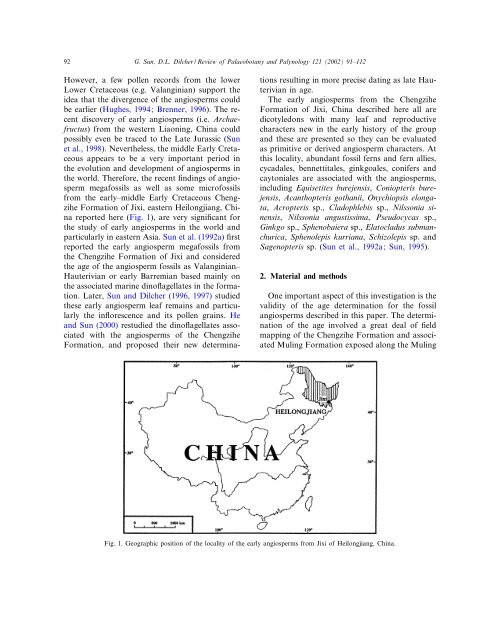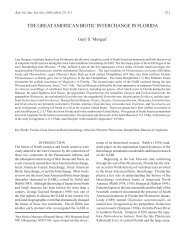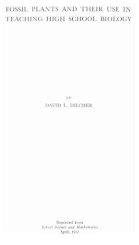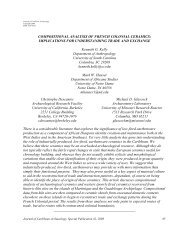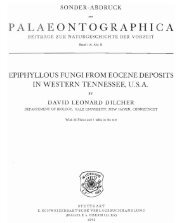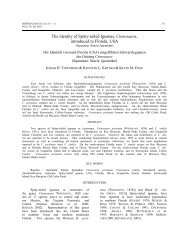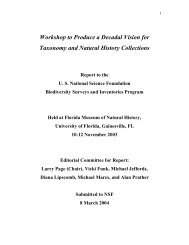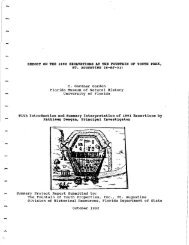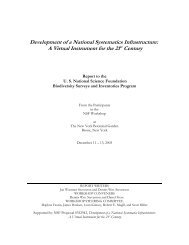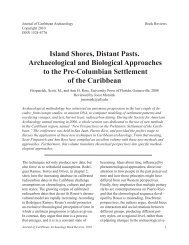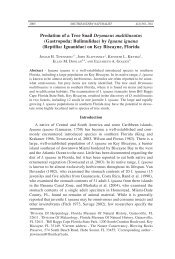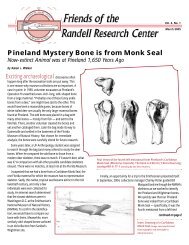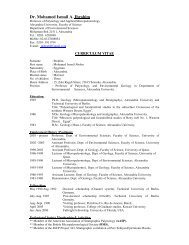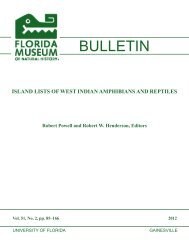Early angiosperms from the Lower Cretaceous of Jixi, eastern ...
Early angiosperms from the Lower Cretaceous of Jixi, eastern ...
Early angiosperms from the Lower Cretaceous of Jixi, eastern ...
You also want an ePaper? Increase the reach of your titles
YUMPU automatically turns print PDFs into web optimized ePapers that Google loves.
92<br />
G. Sun, D.L. Dilcher / Review <strong>of</strong> Palaeobotany and Palynology 121 (2002) 91^112<br />
However, a few pollen records <strong>from</strong> <strong>the</strong> lower<br />
<strong>Lower</strong> <strong>Cretaceous</strong> (e.g. Valanginian) support <strong>the</strong><br />
idea that <strong>the</strong> divergence <strong>of</strong> <strong>the</strong> <strong>angiosperms</strong> could<br />
be earlier (Hughes, 1994; Brenner, 1996).The recent<br />
discovery <strong>of</strong> early <strong>angiosperms</strong> (i.e. Archaefructus)<br />
<strong>from</strong> <strong>the</strong> western Liaoning, China could<br />
possibly even be traced to <strong>the</strong> Late Jurassic (Sun<br />
et al., 1998).Never<strong>the</strong>less, <strong>the</strong> middle <strong>Early</strong> <strong>Cretaceous</strong><br />
appears to be a very important period in<br />
<strong>the</strong> evolution and development <strong>of</strong> <strong>angiosperms</strong> in<br />
<strong>the</strong> world.Therefore, <strong>the</strong> recent ¢ndings <strong>of</strong> angiosperm<br />
megafossils as well as some micr<strong>of</strong>ossils<br />
<strong>from</strong> <strong>the</strong> early^middle <strong>Early</strong> <strong>Cretaceous</strong> Chengzihe<br />
Formation <strong>of</strong> <strong>Jixi</strong>, <strong>eastern</strong> Heilongjiang, China<br />
reported here (Fig.1), are very signi¢cant for<br />
<strong>the</strong> study <strong>of</strong> early <strong>angiosperms</strong> in <strong>the</strong> world and<br />
particularly in <strong>eastern</strong> Asia. Sun et al.(1992a) ¢rst<br />
reported <strong>the</strong> early angiosperm megafossils <strong>from</strong><br />
<strong>the</strong> Chengzihe Formation <strong>of</strong> <strong>Jixi</strong> and considered<br />
<strong>the</strong> age <strong>of</strong> <strong>the</strong> angiosperm fossils as Valanginian^<br />
Hauterivian or early Barremian based mainly on<br />
<strong>the</strong> associated marine dino£agellates in <strong>the</strong> formation.Later,<br />
Sun and Dilcher (1996, 1997) studied<br />
<strong>the</strong>se early angiosperm leaf remains and particularly<br />
<strong>the</strong> in£orescence and its pollen grains. He<br />
and Sun (2000) restudied <strong>the</strong> dino£agellates associated<br />
with <strong>the</strong> <strong>angiosperms</strong> <strong>of</strong> <strong>the</strong> Chengzihe<br />
Formation, and proposed <strong>the</strong>ir new determina-<br />
tions resulting in more precise dating as late Hauterivian<br />
in age.<br />
The early <strong>angiosperms</strong> <strong>from</strong> <strong>the</strong> Chengzihe<br />
Formation <strong>of</strong> <strong>Jixi</strong>, China described here all are<br />
dicotyledons with many leaf and reproductive<br />
characters new in <strong>the</strong> early history <strong>of</strong> <strong>the</strong> group<br />
and <strong>the</strong>se are presented so <strong>the</strong>y can be evaluated<br />
as primitive or derived angiosperm characters.At<br />
this locality, abundant fossil ferns and fern allies,<br />
cycadales, bennettitales, ginkgoales, conifers and<br />
caytoniales are associated with <strong>the</strong> <strong>angiosperms</strong>,<br />
including Equisetites burejensis, Coniopteris burejensis,<br />
Acanthopteris gothanii, Onychiopsis elongata,<br />
Acropteris sp., Cladophlebis sp., Nilssonia sinensis,<br />
Nilssonia angustissima, Pseudocycas sp.,<br />
Ginkgo sp., Sphenobaiera sp., Elatocladus submanchurica,<br />
Sphenolepis kurriana, Schizolepis sp.and<br />
Sagenopteris sp.(Sun et al., 1992a; Sun, 1995).<br />
2. Material and methods<br />
One important aspect <strong>of</strong> this investigation is <strong>the</strong><br />
validity <strong>of</strong> <strong>the</strong> age determination for <strong>the</strong> fossil<br />
<strong>angiosperms</strong> described in this paper.The determination<br />
<strong>of</strong> <strong>the</strong> age involved a great deal <strong>of</strong> ¢eld<br />
mapping <strong>of</strong> <strong>the</strong> Chengzihe Formation and associated<br />
Muling Formation exposed along <strong>the</strong> Muling<br />
Fig.1.Geographic position <strong>of</strong> <strong>the</strong> locality <strong>of</strong> <strong>the</strong> early <strong>angiosperms</strong> <strong>from</strong> <strong>Jixi</strong> <strong>of</strong> Heilongjiang, China.


